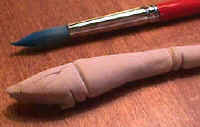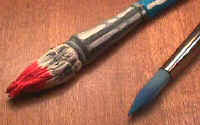
Common Object Replicas
Submitted by C. J. Potter
Set up the materials along with a box of everyday objects that can be reproduced.Anticipatory set:
"We are around and use objects everyday that are little sculptures… interesting works of art that go unnoticed in our busy lives. Today we will look at some objects, and choose one to make a "replica" of. Our goal is to make a replica so convincing that people think that it is the actual object".
Introduction:
Level: Middle School & High School
Time needed: 2-4 sessions
Materials:
- Creative Paperclay® modeling material
- Acrylic or tempera paint and brushes
- Toothpicks
- Popsicle sticks or wooden/ plastic clay tools to form clay
- Various textured objects to stamp clay
- Newsprint paper (2 per student)
- Pencils
- Small scale common objects such as toothbrushes, keys, pencil, floppy disk, pencil sharpener, etc.
Objectives:
The learner will:
- Choose an everyday object and draw it from several views.
- Use Creative Paperclay® to render the object
- Reproduce scale, proportion and textural qualities in order to make a convincing "replica" of object.
- Mix and apply necessary colors for surface of the object.
Lesson Activity:
Day 1: Have several common objects in a box in the front of the room (or ask students to bring some that have a sense of sculptural integrity). Also have pencils and newsprint or sketch books prepared to draw the objects. (Optional: Have the work of Claus Oldenburg on slide or poster, showing students use of common objects in art).
Day 2, 3, 4: Students have small amount of Creative Paperclay®, in a plastic bag, along with their object they have chosen. A clean surface will be necessary to sculpt on, along with the sculpting tools listed above.
Procedure -
Introduce lesson using above anticipatory set, and talking about the sculptural integrity of objects in the room. (example: what makes some objects sculpturally interesting, while others are boring?)Have students pick an object that they think has sculptural integrity, and they would like to replicate.
Instruct students to do a multi-view drawing of the object paying particular attention to proportion.
When students have "studied" the objects (by drawing in scale), instruct them on the use and makeup of Creative Paperclay®.
Students will use tools and fingers to create a scaled replica of the object. In order for the object to look authentic, have them create a weathered look by denting, scratching, or warping the shapes they make. Instruct them that they can add color and lettering later, for now to concentrate on proportion and surface texture.
When sculpting is complete, let clay dry in open air (on a screen rack works GREAT!)
Paint objects according to original color scheme and lettering styles. When printing is extremely small on object, students may use a small series of dashes and dots to simulate lettering.
Paint the objects according to the way the original object looks
When students are finished, speak with the class about possible presentations of the work. For example, putting replicas in a display case with the actual objects
Assessment:
Students may write reflections on the process and product, and conference with instructor about project grade based on:
Copyright © 1999 Creative Paperclay ® Co. & C.J. Potter Illustration
- Craftsmanship
- Proportion (in relation to original object)
- Sculptural Integrity of product
- Likeness to original object.





